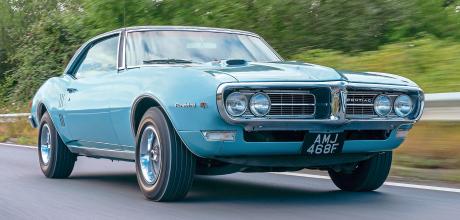1968 Pontiac Firebird 400
Pete Wolfe’s 1968 Pontiac Firebird 400 is a stunning example – so good he just couldn’t resist buying it.
Words: Mike Renaut
Photography: Matt Richardson
Rare Blue Bird
Pete Wolfe had never intended to buy an American car; he already had a beautifully restored 1972 Jaguar E-type V12 roadster and that was enough. “But in 2017 I was at my friend Gary Denham’s place, Executive Cars in Essex. Gary previously restored my Jaguar, and I saw the Firebird in his showroom. I’d always liked American cars, I used to go to Brands Hatch and watch the saloon car races and there was one racing Camaro run by Malcolm Gartlan and Wiggins Teape that I especially loved seeing. Plus of course I watched all those films and TV shows; Bullitt got me in love with muscle cars and my brother had a mechanic business in Norfolk so I even drove a few Yanks in my teens. But I’d never seriously considered owning one until I saw this Firebird.

“The Firebird just had the right look and colour,” continues Pete. “Gary had imported it from Tucson, Arizona but wasn’t planning to sell the car. He only agreed after I talked him into it when he phoned me later that day. He’s quite OTT about his cars being in perfect condition and this Pontiac obviously was – that was part of the appeal for me. It apparently had a $100,000-plus restoration in America and I can believe that. I understand it was completely stripped then restored using all original parts. It was done really well.
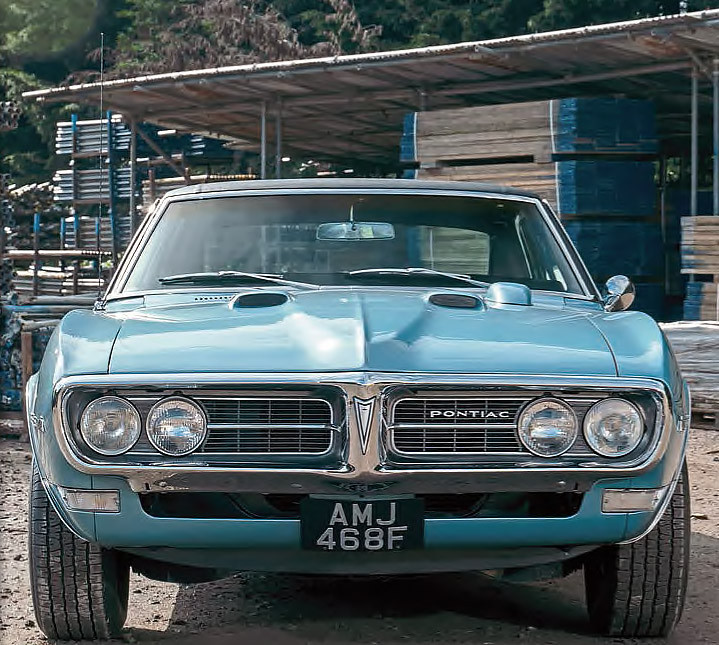
“I use it for car shows and sunny day drives. To be honest I don’t drive it much. My wife Linda likes the Pontiac, although she’s less keen on being a passenger with the left-hand drive, so she prefers the right-hand drive E-type. I do enjoy being asked questions about the Firebird though, whenever I stop someone always walks over to chat about the car.
“It also amazes me how many parts are available. I thought being American it would be trickier than sourcing bits for the Jaguar but it isn’t.” Not that the Firebird has needed much – just the usual service items; bulbs, spark plugs, filters… “That’s the great thing about an old car – I can open the bonnet and I recognise what every part is, unlike with a new one I’m never frightened to work on this. Everything works except the clock, when the electric windows packed up that was easily fixed with a spray of contact cleaner.

“It appears to be all the original glass and it amuses me that in a smallish car there’s an extra length belt adjustment for the front seat for oversized Americans.”
Pontiac’s Camaro
In June 1966 Chevrolet’s ‘Panther’ project was announced to the press. A sporty coupe called Camaro, it was General Motors’ answer to Ford’s wildly successful Mustang. Pontiac Motor Division would produce a sister car, but PMD’s general manager John Z DeLorean wanted it to be more than just a mildly disguised Camaro.
DeLorean favoured a 1963 styling concept called the XP- 833 and further developed that into five two-seater prototypes and one four-seater, since he suspected management would worry a two-seater would harm Corvette sales. Consumer testing also suggested four seats was the way to go and executive vice-president Ed Cole ordered DeLorean to ‘make a car out of the Camaro’. Pontiac engineer Bill Collins recalled the 1967 Firebird was ‘inherited from Chevrolet, the body had all the Chevrolet sheetmetal except the grille and tail-lamps.’ In a six-month computer-aided design frenzy Pontiac’s engineers added five inches to the Camaro’s front end, creating a beaked nose within a classic Pontiac split grille. Underneath were refinements not included in Chevrolet’s design including rear traction bars, an engine mounted further back for better weight distribution and suspension set an inch lower than the Camaro’s. Safety was considered too, with a collapsible steering column, foam-filled windshield pillar mouldings, crushable armrests, dual circuit brakes and fourway hazard flashers. Also innovative was a space-saver spare tyre inflated using a can of Freon.
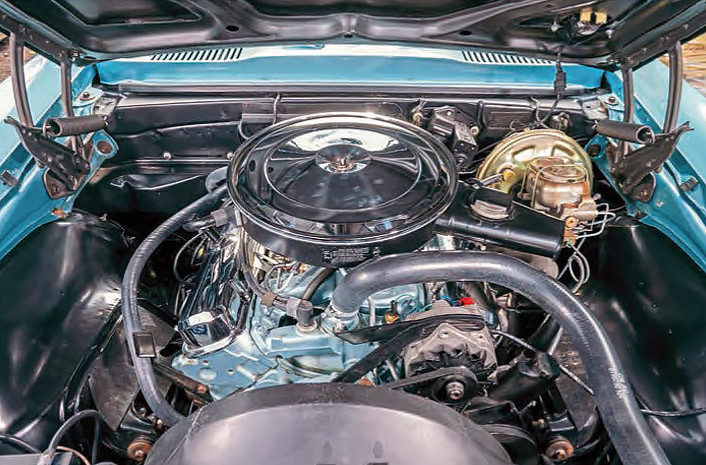
Pontiac borrowed the name from the 1954 concept gas turbine car Firebird I. Introduced on February 23, 1967, the Firebird was indeed a dressed-up Camaro, according to most reviewers – but this wasn’t really a criticism since the Camaro was already proving itself very capable. Road & Track felt the Firebird ‘may be the first step toward a true four-passenger GT car in the best European sense’.
Firebird was available in five model options to which further options could be added. This meant production was simplified and there was a Firebird for every budget, with further potential profits to be made from encouraging a buyer to upgrade. The base 1967 Firebirds were available as coupe or convertible with an innovative overhead cam 230cu in straight-six. The six was borrowed from the 1966 Tempest and featured a glass fibre reinforced cambelt. Engineers evaluated it by installing the engine into a Jaguar E-type. Other Firebird powerplants were 326 or 400cu in V8s borrowed from the GTO. A Rochester single- or four-jet carburettor was used following a 1966 General Motors edict that multi-carb induction was no longer allowed. More than two-thirds of the ‘67 Firebirds were ordered with power steering and brakes, suggesting that while Camaro was certainly a Mustang rival the Firebird was in reality more a competitor to Mercury’s Side marker light. luxury Cougar.

For 1968 the Firebird door glass was now one-piece thanks to a new ventilation system. Interiors got tweaks including new instrument lenses while seats were finished with ‘dielectric embossing in genuine expanded vinyl.’ Fancy… A press release from September 13, 1967 explained the new ‘68 Firebirds had staggered rear shocks (the left one now mounted behind the rear axle) and multi-leaf springs to cure wheel hop under acceleration – they’d been developed for the 1967 cars but not completed in time.
The overhead cam 230 six was now 250 cubic inches and again Firebirds came with a single-barrel Mono-Jet carburettor (175bhp) or optional 215bhp four-barrel in the Sprint model. Last year’s 326 V8 now became a 350cu in producing 265bhp with the single-barrel or 320bhp with the High Output four-barrel carb. The 400cu in engines were all four-barrel equipped and available in HO versions or the rare $616 Ram Air with functional hood scoops.
Every Firebird model offered three-speed manual as standard with optional four-speed, or a three-speed automatic transmission. Little else needed changing since a major external restyle was coming for 1969 that included a popular new $725 option called the Trans Am.
Box ticking
“My Firebird didn’t really come with any history,” says Pete, “but my brother Alan has done a lot of research for me – since he retired he enjoys going online and finding out info.” So thanks to Alan we know this Firebird was built at the Lordstown, Ohio plant, was around the 15,000th built – from a production total of 107,112 for the 1968 model year – and got sold through Gianera Pontiac Ltd of La Crescenta, Los Angeles. Leading me to wonder why they didn’t simply get it locally from the plant at Van Nuys…
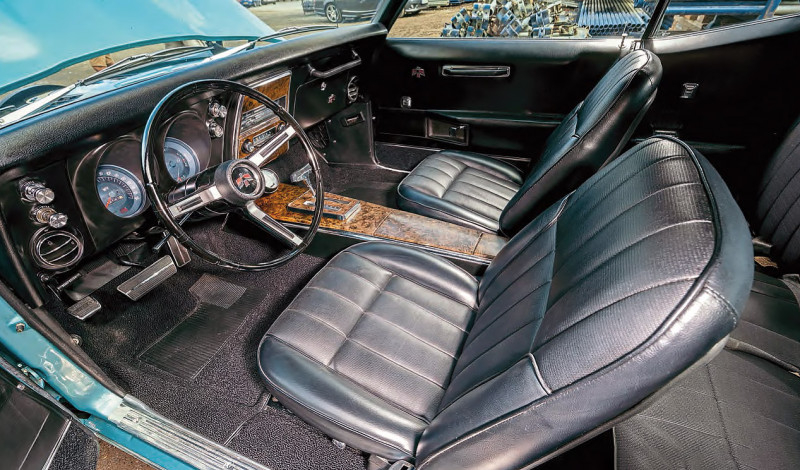
It appears this ‘bird was ordered as a showroom car rather than built for a specific buyer and it came with a lot of options. The Meridian Turquoise Firebird Hardtop Coupe with black interior (option 59 trim) got the Cordova (vinyl) top for $84.26. Its Firebird 400 pack consisted of a four-barrel V8 carb with chromed air cleaner, rocker (valve) covers and oil cap, dual exhausts, power flex fan, hood scoops and a standard three-speed manual transmission. That added a further $273.83.
This Firebird then received the Turbo Hydramatic automatic gearbox ($236.97), push-button radio ($61.09), rear seat speaker ($15.80), Rally II wheels ($63.19), centre console ($50.55), electric clock ($15.80), Wonder Touch power steering ($94.79) and power brakes ($42.13) with a $63.19 upgrade to front disc brakes. Soft Ray tinted glass all round cost $30.54 and power windows were $100.05. The $114.80 custom trim option added deluxe wheel discs (outer trim rings), windshield pillar, door, side and wheel opening chrome mouldings as well as extra trim inside around the pedals and seats. The rear seat was optioned as a folding type ($42.13) and a luggage lamp for the trunk added a further $3.16 to the total. White sidewall F70x14 tyres were fitted at no extra cost.
Those options added a healthy $1292.28 to the $2758 base price. Throw in a delivery fee of $150 from Ohio to California and this Pontiac was out the door for $4200.28, not including local or state taxes and licence fees.
As for the driving experience: “Well it’s noisy but not especially fast,” laughs Pete. “The automatic gearbox is fine but I do wish it was a manual transmission as it would suit the muscle car image better – but that’s perhaps the only thing I’d change.
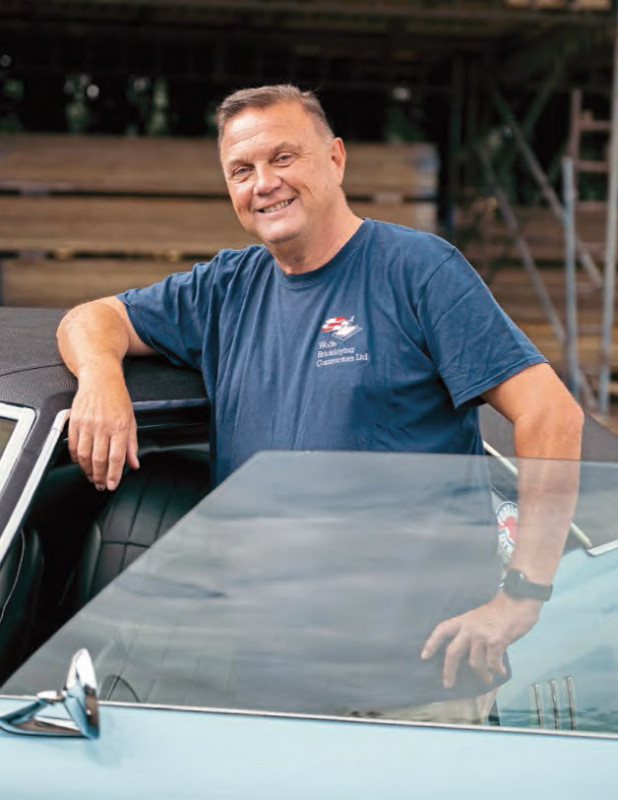
“I love the rev counter on the bonnet – that’s actually really handy, but I find the power steering to be very light. I quickly took it off the original cross-ply tyres since they were a nightmare for handling. I love the sound too, it’s incredible under power and it just purrs at idle. It doesn’t take much to smoke the rear tyres either.
“I’d quite fancy a classic Mustang or a Dodge Charger but I’ve certainly no plans to sell my Firebird, it’s such a lovely example of a rare car.”
Firebird wears a classic Pontiac split grille. Firebird 400s came standard with a husky 330bhp 400cu in V8.
Firebirds came with a space-saver tyre. Power brakes are dual circuit for safety.
GM artists Fitz & Van… … came up with some great renderings for marketing the Firebird.
Side marker light. Hood-mounted tach.
“IT ALSO AMAZES ME HOW MANY PARTS ARE AVAILABLE. I THOUGHT BEING AMERICAN IT WOULD BE TRICKIER THAN SOURCING BITS FOR THE JAGUAR BUT IT ISN’T.”
Pontiac’s new for ’68 Federal side lights were in the shape of the Pontiac logo. Nice touch!To take it a notch up from the Camaro, there
was a lot of faux walnut used on the interior.
Jag-like, apart from not being real wood! Double binnacled dash. Pete Wolfe, Pontiac man.


